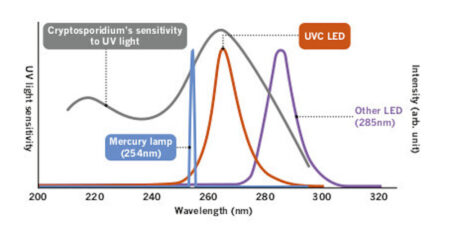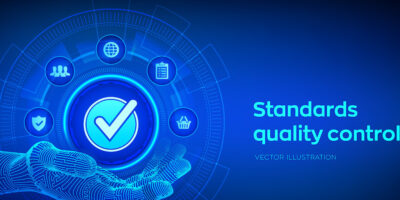Safe for humans, deadly for viruses: UVC LEDs power advanced germicidal technology
The global pandemic has focused attention on dealing with dangerous microorganisms. Viruses, as well as bacteria, have been present in the environment for longer than humans. With our capacity to create technologies, we have developed the ability to protect ourselves from these natural bio-hazards.
Various techniques are in use, including the use of HEPA (High-Efficiency Particulate Air), carbon and ceramic filters, germicidal chemicals, ionisers and plasma systems, and ultraviolet (UV) radiation. As with so many things in life, none of these is a universally perfect solution. All have limitations and some have important drawbacks.
Filters can exclude pathogens and pollutants from indoor environments and water supplies. Although effective at trapping viruses, they are unable to destroy them. Moreover, the filter media must be replaced periodically.
Chemical products such as chlorine can kill viruses on contact. However, treating surfaces by manually wiping is laborious and time-consuming, as well as being vulnerable to human error. Frequent cleaning is not possible in some situations and using chemicals does not address the airborne threat. The chemicals themselves can present safety risks and pathogens can develop resistance over time.
Ionisers and plasma systems can kill viruses present in the ambient environment but produce ozone, which is harmful to human health.
UV irradiation can be used against microorganisms existing on surfaces, in the air, or in water. Historically UV radiation has been generated through gas discharge using low/medium-pressure mercury vapour lamps. However, energy-conscious legislation banning ballasts for these lamps has been in force for some time in various territories. In addition, the UN Environment Global Mercury Partnership is now addressing the toxic effects through initiatives such as the Minamata Convention on Mercury, which bans the manufacture, import, and export of mercury lamps.
UV LEDs now present an alternative to mercury lamps that are power-efficient, safe, and permissible to use worldwide. The LEDs also deliver performance advantages including a more consistent spectral output, as well as being smaller and more robust than mercury vapour lamps. Thanks to these new light sources, UV irradiation can become an even more powerful ally in the fight against COVID-19.
UV Wavelengths and Applications

The UV spectrum covers wavelengths from about 100nm to 400nm and is divided into three regions, UVA (400nm – 315nm), UVB (315nm – 280nm), and UVC (280nm – 100nm). Different types of UV LEDs are available, with spectral output in each of these regions. Multi-UV LEDs are also being developed, which should allow the flexibility to address a wide variety of applications.
UVA LEDs are used in applications such as dentistry and cosmetics and for industrial purposes such as curing resins, adhesives, and paints. UVA is the safest range of wavelengths for humans to work with. The use of UV-filtering safety glasses is recommended.
UVB LEDs are often used in medical applications such as phototherapy and dermatological treatments. UVB wavelengths encourage the formation of vitamin D in the skin, although excessive exposure can cause skin burns and eye damage.
Radiation in the UVC region has the most effective germicidal properties. These are the shortest and most energetic wavelengths, and hence the most damaging to living cells. The energy at these wavelengths can destroy the DNA of pathogens thereby inactivating them and preventing further reproduction.
UVC LEDs in Action

Typical contexts for germicidal UVC radiation include in-duct systems within HVAC equipment, used to kill airborne viruses, as well as upper-air in-room UVC systems and portable in-room devices for air purification and treatment of surfaces. The international standard ISO 15858:2016 sets out minimum specifications for UV-C devices to ensure human safety, including exposure limits and the use of warning signs for protection.
The standard recognises that UVC has only limited ability to penetrate the skin. About 4-7% of UVC radiation across wavelengths from 250nm to 400nm is reflected or absorbed in the outer epidermis, which contains mostly dead skin cells that are continually shedding. Ocular damage, however, can occur and, although not permanent, can take several days to resolve in cases of acute over-exposure.
Typical UVC disinfection systems operate in the wavelength range from 254nm to 270nm. Far UV wavelengths in the 207nm-222nm range are also used.
When designing with UVC LEDs for sterilisation applications, the radiation intensity is a key parameter that must be evaluated. The inverse square law, which describes the rate at which electromagnetic radiation intensity reduces with distance from the source, dictates that the LED emitter is most effective when placed as near as possible to the surface to be treated. In addition, lenses can be used to concentrate the beam energy into a target area and hence minimise the power and the exposure time needed for effective disinfection. Interchangeable UV lenses can give users flexibility to scale the irradiation output according to the application.
When using UVC within HVAC systems to kill airborne viruses, the airflow rate and geometry of the system are key considerations, in addition to the radiation intensity. A suitable place to position the LEDs can be in ducting at the outlet of a fan, where the airflow is most stable.
For equipment to disinfect surfaces, UVC LEDs with outputs of 2–4mW, powered with about 20mA drive current, can be a good choice for larger surfaces. Smaller-scale applications can be tackled with compact, mid-power UVC LEDs.
On the other hand, high-power UVC LEDs operating at about 100mW are needed for applications such as treating drinking water and pools. These are typically driven at up to 250mA.
Emergency installations created to protect frontline workers include a disinfection tent for cleaning the protective clothing of medical staff at the Huoshenshan Hospital in Wuhan, China, to protect staff and prevent the virus spreading outside the hospital. UVC emitters were fitted to the reflective surfaces of the ceiling, walls, and flooring. During the 30-second disinfection process, the UVC LEDs provide a dosage of 6 mJ/cm2 with a consistent brightness of 200 μW/cm2.
Demand Driving Growth

Germicidal UVC lamps have been available for some time, in various forms including fixed and portable lamps as well as mobile lamps mounted on autonomous robots. Before the global COVID-19 pandemic, the total market for UVC LEDs was worth about $144 million.
The situation has now changed significantly. Analysis by research firm Yole Développement found that demand for UVC LEDs surpassed supply during 2020. The fight against the virus has driven greater demand for these components to perform disinfection in frontline roles and during cleaning of places where people assemble, such as waiting rooms, cinemas, theatres, buses, trains, and passenger aircraft.
Yole’s research found that the LED industry is working to increase manufacturing capacity to meet the increased demand. The UVC LED market is expected to exceed $2.5 billion by 2025, representing a CAGR of 61% since 2019.
Conclusion
UVC LEDs are a safe source of radiation that can be used to protect people and places against harmful microorganisms including the COVID-19 virus. In addition to being inherently safe and approved for use worldwide, containing no mercury, they are also energy efficient, labour-saving, and effective in fixed and mobile UVC lamps for multiple roles including disinfecting surfaces, water, and the ambient environment. UVC LEDs are an important ally in the fight against COVID-19 and the current high demand is expected to continue as the pandemic subsides.




